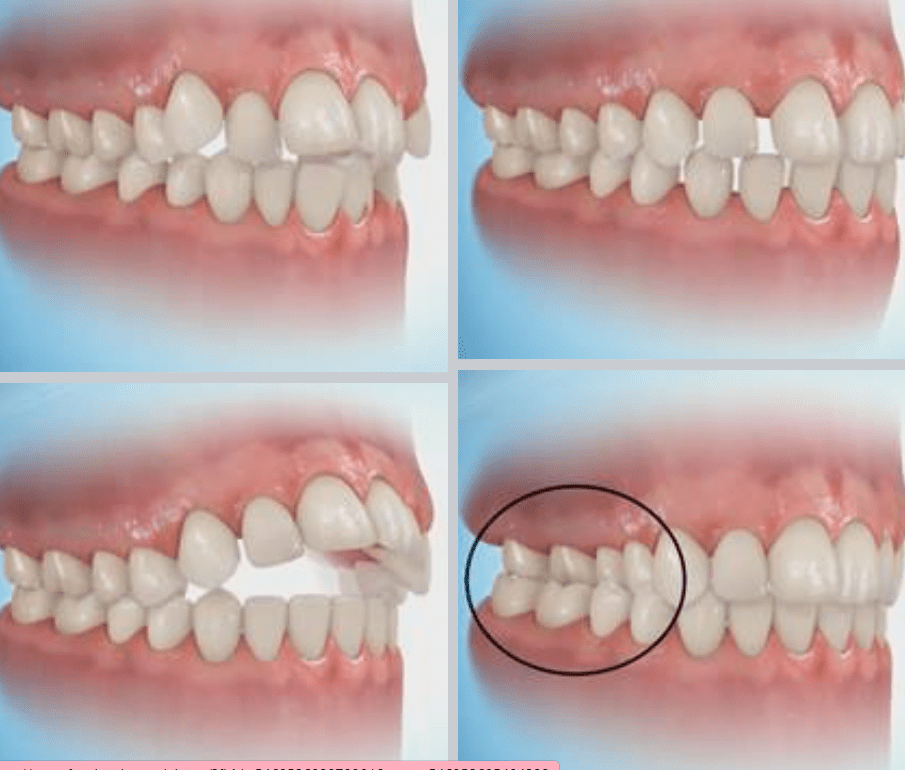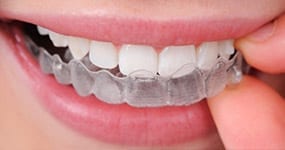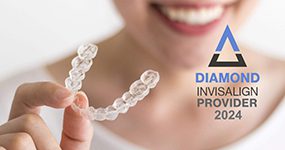Underbite vs overbite explained

Bite alignment influences your overall appearance and health. ‘Malocclusion’ is the term used for some form of bite misalignment, whereby the upper and lower teeth do not come together as they should when closed.
The most common types of malocclusion are underbites and overbites. In both cases, one row of teeth protrudes far more than the other, often leading to speech, chewing and breathing issues.
But what is an underbite vs overbite?
To help you work out which malocclusion you may have, we compare the differences between underbites and overbites.
Read on to discover the symptoms, causes and orthodontic treatment options for each malocclusion.
What’s the difference between an overbite and underbite?
Overbites and underbites are similar in that one jaw, and therefore its row of teeth extends beyond and in front of the other. The key difference between an underbite vs overbite rests in whether the upper or lower jaw protrudes more – an overbite involves a protruding upper jawbone (maxilla), whereas an underbite is related to a protruding lower jaw (mandible).
Despite this fundamental distinction, both malocclusions must be diagnosed and corrected by an experienced orthodontist. Keep reading to learn more about each condition.
What is an overbite?
An overbite develops when the upper jaw and front teeth overlap the lower jaw and front teeth. Overbites are the most common malocclusion in both adults and children.
While it is normal for your teeth to slightly overlap (this prevents enamel wear), any overbite over 3 mm is an orthodontic concern¹. An overbite beyond 10mm is considered severe.
Overbites can be skeletal or dental. Skeletal overbites occur when the jawbone develops incorrectly, causing the upper jaw and front teeth to jut out over the bottom jaw and front teeth. On the other hand, dental overbites occur when the teeth themselves are misaligned.
Learn more about the causes of overbites below.
Overbite causes
1. Overcrowding
Overcrowded teeth are the main cause of overbites because your teeth are not correctly aligned. If you find it difficult or uncomfortable to bite down, then you may subconsciously alter your bite alignment until an overbite becomes the default.
2. Genetics
If your lower jaw is too small, you may develop an overbite. As the upper jaw is larger than the lower jaw, your top teeth extend farther outward, in turn overlapping your bottom teeth too much.
3. Teeth grinding
Overbites can also be caused by teeth grinding, otherwise known as bruxism. This habit can occur while you are asleep or awake and is often sparked by stress, sleep apnea, caffeine or medication. Continued grinding wears down your enamel, sometimes to the point where you develop an overbite.
4. Excessive tongue pressing
Pressing your tongue against your front teeth too often can gradually cause them to grow outward, leading to teeth misalignment and an overbite.
What is an underbite?
An underbite occurs when your lower jaw and front teeth extend out and over your upper jaw and front teeth. This malocclusion is often related to improper jaw development. Therefore, it’s recommended that you treat an underbite early so that the upper jaw’s growth can be corrected, and in turn the lower jaw’s.
Below, we break down the common causes of an underbite.
Underbite causes
1. Genetics
The majority of underbites develop due to inherited dental or skeletal traits that cause the lower jaw to grow too much, the upper jaw to not grow enough, or a blend of both. Certain birth defects, like cleft palate, can also lead to an underbite.
2. Childhood habits
Underbites are often the result of oral and myofunctional habits during early jaw bone development. These include bottle feeding after 12-18 months, thumb sucking after age two, and dummy use after age four.
3. Injury
Lastly, underbites can be caused by physical trauma to the face or jaw. Some of the most common examples are tumours and blunt force.
What complications can arise from misaligned bites?
Left untreated, both an underbite and overbite can cause issues such as:
- Uneven wear and tear on enamel;
- Trauma to the front teeth;
- Heightened risk of tooth decay and gum disease;
- Speech problems;
- Chewing difficulties;
- Bruxism or teeth grinding;
- Sleep apnea;
- Mouth breathing;
- Jaw and temporomandibular joint (TMJ) pain;
- Headaches.
Additionally, an overbite can lead to an increased risk of gum and soft tissue damage, as well as painful mouth ulcers.
When it comes to cosmetic concerns, an overbite may create the appearance of a receded chin, while an underbite causes the lower jaw to jut out.
Underbite vs overbite treatment options
As underbites are most often skeletal, they tend to be more complicated to correct than overbites, and should ideally be addressed at a young age to avoid the need for surgery. However, your orthodontist will discuss your treatment options with you after assessing your unique oral anatomy.
Common treatment options for both types of malocclusion include a palate expander, braces, Invisalign and orthognathic surgery. Let’s dive into each of these options below.
Palatal expander
With early intervention, it is possible to fix an overbite or underbite with a palatal expander. This orthodontic appliance guides jaw development to correct the discrepancy in size between your upper and lower jaw.
It does this by enlarging the roof of the mouth and widening the jaw with gentle, steady force. This can reduce the need for orthognathic surgery in later life.
Of course, suitability for this oral appliance will depend on your anatomy and the exact cause of the malocclusion.
Braces
Braces are an effective way to align an overbite or underbite. While braces alone may be sufficient to fix some bite problems, they are most often combined with rubber bands or another oral appliance.
While the braces work to straighten your teeth, the rubber bands that attach to each arch deliver the connective pressure required to gradually move the lower jaw forward and upper jaw back, or vice versa.
Invisalign
In some cases, Invisalign can be worn to correct an underbite or overbite with unparalleled subtlety. These clear, plastic aligners can correct your bite while straightening your smile. And with amazing offerings like Invisalign with Mandibular Advancement (MA), it is becoming even easier to correct bite problems.
These aligners feature precision wings that activate when you bite down. In turn, the lower or upper jaw is brought forward until it aligns with the upper or lower jaw, respectively.
Additionally, we will typically bond Invisalign attachments, which look like enamel-coloured buttons, to your teeth so that these aligners have something to push against for more strength. Rubber bands may also be used with the aligners to boost the connective force that helps to align your bite.
Orthognathic Surgery
Orthognathic surgery is an invasive procedure on the jaw that is used to correct an underbite or overbite. It can include jaw repositioning, bone grafting, and shortening or extending the jaw bone.
With the advancement of non-invasive treatment options, this operation is becoming less common. However, it is still a great option for adult patients with severe malocclusions and fully-developed jaw bones.
This treatment plan usually involves wearing braces or Invisalign before undergoing corrective jaw surgery. When your jaw has healed, you may be advised to use braces or Invisalign again to achieve final adjustments.
Book a visit to an orthodontist in Newcastle, NSW
Now that you know the difference between an overbite vs underbite, you are one step closer to taking the right action for your oral health and smile. This is great news, as for both malocclusions, the earlier you intervene the better.
If you are experiencing bite issues, ABC Orthodontics can help you to determine whether you have an overbite, underbite, or crossbite – plus the best way to correct it at any age.
To book an appointment for early orthodontic treatment or adult orthodontic treatment in Newcastle, please get in touch with our friendly team today at 1300 794 797.
References:
1. Fattahi, Hamidreza, et al. “Skeletal and Dentoalveolar Features in Patients with Deep Overbite Malocclusion.” Journal of Dentistry (Tehran, Iran), Tehran University of Medical Sciences, Nov. 2014, https://www.ncbi.nlm.nih.gov/pmc/articles/PMC4281184/.



